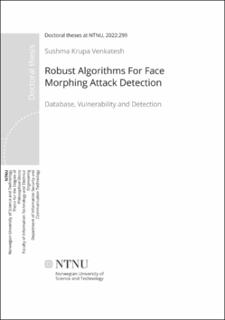| dc.contributor.advisor | Busch, Christoph | |
| dc.contributor.advisor | Raja, Kiran | |
| dc.contributor.author | Venkatesh, Sushma Krupa | |
| dc.date.accessioned | 2022-09-28T07:18:14Z | |
| dc.date.available | 2022-09-28T07:18:14Z | |
| dc.date.issued | 2022 | |
| dc.identifier.isbn | 978-82-326-5932-6 | |
| dc.identifier.issn | 2703-8084 | |
| dc.identifier.uri | https://hdl.handle.net/11250/3022013 | |
| dc.description.abstract | Biometrics has emerged as a promising technology for automated recognition of individuals. The stored biometric characteristics are used to recognise an individual and hence biometrics technology plays a major role in security-related applications and stands in the front-line for authentication of data subjects. Biometrics has a wide range of applications in law enforcement, surveillance, banking, border control, medical records, time and attendance tracking etc. As the inherent biometrics characteristics don’t undergo any changes, biometric technology has shown the best performance for authentication of data subjects.
Though biometrics technology is promising for person authentication, attackers may employ various techniques like presentation attacks and adversarial attacks to impersonate an enrolled individual with interest to obtain unauthorised access to the system. In addition to these attacks, in relatively recent times, biometric are attacked in the facial image enrolment stage, especially in the ID related applications, by performing face morphing. Facial morphing is initially performed for entertainment purposes, but gradually it has been used to attack face recognition systems. The face morphing process combines two different facial identities to generate a single facial image with the facial representations of both identities. An attacker may use the morphed facial image to enrol it in the ID documents (like driving license, passport). Since the morphed facial image shows a high resemblance to both facial identities, the ID document can be claimed by both identities. This indicates the severity of facial morphing and the necessity of morphing attack detection mechanisms to avoid the security lapse.
Hence the primary objective of this thesis is the development of face morphing attack detection techniques using hand-crafted and deep learning approaches. During this doctoral work, morphing attack detection approaches are developed for both digital and print-scan datasets. To empirically evaluate the performance of the newly generated morphing attack detection approaches, various face morphing databases are generated using landmark and deep learning-based GAN techniques. Furthermore, the vulnerability of face recognition systems to face morphing attacks with ageing co-variate is evaluated. To this extent, this doctoral thesis contributes with the novel morphing attack detection approaches. | en_US |
| dc.language.iso | eng | en_US |
| dc.publisher | NTNU | en_US |
| dc.relation.ispartofseries | Doctoral theses at NTNU;2022:299 | |
| dc.relation.haspart | Article 1:
Venkatesh, Sushma; Zhang, Haoyu; Ramachandra, Raghavendra; Raja, Kiran; Damer, Naser; Busch, Christoph.
Can GAN Generated Morphs Threaten Face Recognition Systems Equally as Landmark Based Morphs? - Vulnerability and Detection. 2020 8th International Workshop on Biometrics and Forensics (IWBF) https://doi.org/10.1109/IWBF49977.2020.9107970 | en_US |
| dc.relation.haspart | Article 2: Zhang, Haoyu; Venkatesh, Sushma; Ramachandra, Raghavendra; Raja, Kiran; Damer, Naser; Busch, Christoph. MIPGAN—Generating Strong and High Quality Morphing Attacks Using Identity Prior Driven GAN. IEEE Transactions on Biometrics, Behavior, and Identity Science 2021 ;Volum 3.(3) s. 365-383 https://doi.org/10.1109/TBIOM.2021.3072349 | en_US |
| dc.relation.haspart | Article 3:
Venkatesh, Sushma; Raja, Kiran; Ramachandra, Raghavendra; Busch, Christoph.
On the influence of ageing on face morph attacks: Vulnerability and detection". In 2020 IEEE International Joint Conference on Biometrics (IJCB), pages 1–10. https://doi.org/10.1109/IJCB48548.2020.9304856 | en_US |
| dc.relation.haspart | Article 4: Venkatesh, Sushma; Ramachandra, Raghavendra; Raja, Kiran; Spreeuwers, Luuk; Veldhuis, Raymond N.J.; Busch, Christoph. Morphed Face Detection Based on Deep Color Residual Noise. I: 2019 Ninth International Conference on Image Processing Theory, Tools and Applications (IPTA). IEEE 2019 ISBN 978-1-7281-3975-3. https://doi.org/10.1109/IPTA.2019.8936088 | en_US |
| dc.relation.haspart | Article 5: Venkatesh, Sushma; Ramachandra, Raghavendra; Raja, Kiran; Spreeuwers, Luuk; Veldhuis, Raymond; Busch, Christoph. Detecting morphed face attacks using residual noise from deep multi-scale context aggregation network. 2020 IEEE Winter Conference on Applications of Computer Vision (WACV) 2020 https://doi.org/10.1109/WACV45572.2020.9093488 | en_US |
| dc.relation.haspart | Article 6: Venkatesh, Sushma; Ramachandra, Raghavendra; Raja, Kiran; Busch, Christoph. Single image face morphing attack detection using ensemble of features. 2020 IEEE 23rd International Conference on Information Fusion (FUSION) 2020 https://doi.org/10.23919/FUSION45008.2020.9190629 | en_US |
| dc.relation.haspart | Article 7: Venkatesh, Sushma; Ramachandra, Raghavendra; Raja, Kiran; Busch, Christoph. Face Morphing Attack Generation and Detection: A Comprehensive Survey. IEEE transactions on technology and society 2021 ;Volum 2.(3) s. 128-145 https://doi.org/10.1109/TTS.2021.3066254 | en_US |
| dc.title | Robust Algorithms For Face Morphing Attack Detection: Database, Vulnerability and Detection | en_US |
| dc.type | Doctoral thesis | en_US |
| dc.subject.nsi | VDP::Technology: 500::Information and communication technology: 550 | en_US |
| dc.description.localcode | IEEE articles included in the thesis - In reference to IEEE copyrighted material which is used with permission in this thesis, the IEEE does not endorse any of [name of university or educational entity]’s products or services. Internal or personal use of this material is permitted. If interested in reprinting/republishing IEEE copyrighted material for advertising or promotional purposes or for creating new collective works for resale or redistribution, please go to http://www.ieee.org/publications_standards/publications/rights/rights_link.html to learn how to obtain a License from RightsLink. | en_US |
